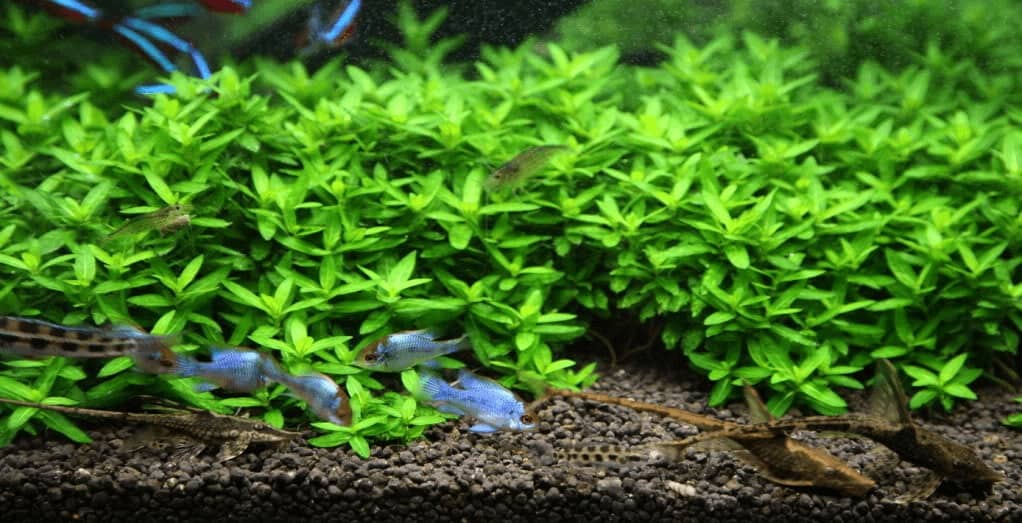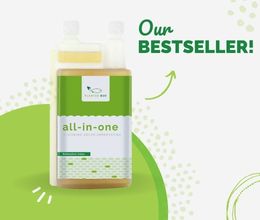The secret to a beautiful, healthy planted aquarium? A good fertilization schedule combined with sufficient carbon (CO2), balanced lighting and adequate water circulation. Quite a task, but fortunately the Estimative Index makes the fertilization part easy.
The idea of the Estimative Index is actually quite simple: you add nutrients to your aquarium until you get a surplus. This way you are sure that your aquarium plants will never have a nutrient deficiency and can grow optimally. “Nutrients aplenty” so to speak, and believe me: your aquarium plants love it.
The Estimative Index: based on an American model
The Estimative Index (EI) was developed by Tom Barr, a professor in biology at an American college specializing in aquatic biology and botany.
The EI is actually an “estimation method”. Because you have added a certain, unrestricted amount of nutrients to the aquarium water, it is no longer necessary to measure the water parameters. Why? Because usually most commercial testers are pretty unreliable. You’ve probably noticed it yourself: brand A’s test kit gives a different result than brand B’s or you have to guess at the value color. So measuring has become guessing. The danger of this is that you can easily draw the wrong conclusions and thus use the wrong fertilization schedule, which ultimately harms your plants. Moreover, with testers, you only take action it’s already too late since the nutrient deficiency is already there and the damage to the plants has been done.

According to Tom Barr, most aquarists are too obsessed with high lighting and don’t think enough about proper CO2 supply and fertilization. Most algae problems in aquariums are due to poor plant growth, which in turn is usually the result of nutrient deficiencies (most often lack of CO2). The Estimative Index provides a solution to this by always adding a small surplus and thus preventing a nutrient deficiency.
How does the Estimative Index work
How do you apply EI to your own aquarium? It is quite simple: it is enough to add fertilizer daily or 2-3 times a week. In aquariums with low light and/or low plant mass, you can even proceed on a weekly basis.
The fertilizers you add are divided into two major groups. On the one hand, you have the “micro nutrients” (trace elements) such as iron, magnesium, manganese, … On the other hand, you have the “macro nutrients” such as nitrate, phosphate and potassium. The weekly minimum and maximum guideline values you can add to your tank are as follows:
- Nitrates: 10 to 30ppm
- Phosphates: 1 to 3ppm
- Potassium: 10 à 30ppm
- Iron & trace elements: 0,5 to 1ppm
For the trace elements we base ourselves on the amount of iron contained in the fertilizer, but you can always add extra iron with an aquarium iron fertilizer. Exactly how many milliliters you need to add to your tank to get to the above ppm values is listed on the back of the fertilizer bottle, at least in the case of the PlantedBox fertilizers.
If you want to make your own DIY aquarium fertilizers you can use a calculator or the provided recipe of the PlantedBox DIY kit. So let’s say you want to achieve a value of 10ppm per 10ml of KNO3 on 100 liters of aquarium water, then the calculator will tell you how many grams of dry salts you need to add to your bottle. If you are using PlantedBox fertilizers, the quick start guide in the DIY fertilizer kit will tell you how many spoons you need to add to your bottle for the correct dosage. It’s super easy.
On day 7, do a heavy water change, preferably about 50% of the water. The water change serves to limit the amount of nutrients in your aquarium. Suppose you dose 20ppm of nitrate and you do a 50% weekly change, you can never get more than 40ppm of nitrate. However, that maximum limit applies to situations where your plants absorb no nutrients at all. Usually, in reality, the maximum limit is much lower because your plants are always going to absorb some fertilizer as nutrition, especially if plant growth is healthy.

A second function of water changes is to get rid of the many waste products your plants produce. As they start growing stronger and faster with the Estimative Index, they also start creating more waste. If this waste is left too long in your aquarium, it will rot, which can cause algae. So by doing regular water changes you reduce the risk of algae. In addition, you introduce a lot of new minerals and CO2 into your tank with the tap water, something your plants will certainly appreciate.
Do you have a very large aquarium and 50% refreshing is not so easy? No problem, you can still use the Estimative Index while doing fewer changes by adding less nutrients. An example: suppose you add 30ppm nitrate and do a 50% refresh and you want to switch to a water change rate of about 25%, then it is sufficient to add 15ppm nitrate.
Does the Estimative Index cause algae?
Many aquarists fear that with the high nutrient values of the Estimative Index, they will have algae. However, that fear is unfounded. Just look at the pictures in this article, these are the tanks with values even higher than those described above, and yet: no algae to be seen.
Why is that? Because the fertilizers we use for Estimative Index dosing is an “inorganic” fertilizer. These products are already in their final stages, there is no rotting process taking place and thus no algae-causing substances. The statement that nitrate & phosphate cause algae in aquariums is actually a holdover from the days when we added those fertilizers via fish food. That fish food would then rot and be converted by the bacteria to nitrates and phosphates. During the rotting process, however, substances were created that caused algae (e.g. ammonium). Unfortunately, the link was wrongly made between nitrate/phosphate and algae and not ammonium and algae. Fortunately, with today’s fertilizers, this is no longer an issue.
Another cause of this erroneous statement, is the fact that higher nitrate & phosphate leads to a higher demand for CO2 (Gerloff, 1966). If you already have a CO2 deficiency and you add extra nitrate and phosphate, the demand for CO2 will increase even more and so will the deficiency. The result: you see more algae and you think it’s because of the extra fertilizer. However, this is not correct since the direct cause of your algae is the CO2 deficiency, the fertilizers only highlighted this problem. In that case, you need to work on your CO2 first and certainly not dose less nitrate and phosphate, because by doing so you risk causing another deficiency.
If you really want a healthy plant tank, then your main focus should be on the health of your plants and not on limiting algae. An aquarium in which the plants live in ideal conditions with sufficient CO2 and plenty of nutrients will have virtually no algae. A tank where you take a preventive approach and limit fertilization out of fear of algae runs a much greater risk of nutrient deficiency and consequently algae. And this can become a dangerous vicious circle after a while.
In short: provide sufficient nutrition so that your plants grow well and the algae will stay away by themselves.
Is the Estimative Index safe for fish?
Another comment you often hear is that the Estimative Index is bad for the health of your fish and shrimp. However, academic research by Camargo (2005) indicates that nitrate is only toxic in very high amounts, much higher than the values we use for Estimative Index dsoing. To give you an example, Camargo’s scientific paper mentions that the newborn larva of the Pimephales promelas has a toxicological limit of 358 mg/l of N-NO3.
However, N is only 14g/mol while NO3 is 62g/mol. So this means that we have to multiply 358 by 4.4 to get the requested ppm NO3. The critical level for this species is 1575 ppm! Which is huge compared to the 30ppm of the Estimative Index. Each fish species has its own critical limit regarding nitrate, but Marco et al. (1999) mentions that the 90mg/l N-NO3 is a “recommended amount of nitrate for warm water fish”. And that’s converted to 396 ppm …
It is more difficult for the other substances because the academic research on them does not exist or is difficult to compare within the context of aquaria. For the toxicity of phosphate, for example, studies do exist, but they were conducted on European lakes, a biotope totally different from our heavily planted aquariums.
So for much of our fertilizers, we are assigned to practice, which shows us that the values we use are fine for our fish. In fact, sensitive fish such as Sturisomas and Discus were found to be able to breed in Estimative Index tanks. The pictures in this article are proof of that.
Some remarks
The Estimative Index is an effective tool, but not a panacea that will turn your tank into a lush jungle.
Many other factors play an important role in the health of your plants like aquarium lighting, filtration, water circulation and CO2. The latter in particular is a sticking point with aquarists. If you do not have an optimal CO2 level in your tank, the Estimative Index will not solve this and your plants will still grow poorly. The only solution then is to increase your CO2 supply and continue dosing according to the Estimative Index.
In such situations, the Estimative Index is ideal for determining the cause of your problems. Suppose your plants are growing poorly and you suspect a nutrient deficiency, you can use the EI to exclude nitrates, phosphates, potassium & trace elements. What then remains are CO2, lighting and water circulation/filtration.









